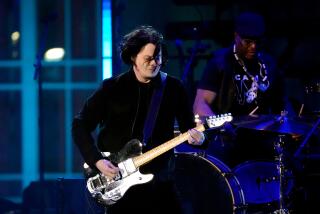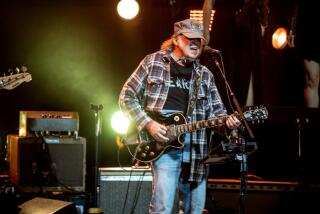Live: the Dead Weather at the Roxy
- Share via
Alison Mosshart’s lips nearly grazed Jack White’s when the pair shared a microphone Wednesday night at the Roxy. The room grew more humid during that encounter, though the singers never touched. Later, when White took one of his showy guitar solos, Mosshart simply stood and stared. Did her locked gaze signify adoration? Or was it hostile -- a silent way of shouting, “Get out of my spotlight”?
In the Dead Weather, the group that unites Mosshart with White, along with guitarist-keyboardist Dean Fertita and bassist Jack Lawrence (who also play with White in the Raconteurs), the foundations of the four-piece rock band are shaken loose just enough to let some interesting complexities surface. The band’s sound is firmly rooted in heavy blues-rock, but the presence of Mosshart up front and White mostly behind the drums turns this revival on its side, if not completely upside down.
Mosshart, a member of the drone-rock duo the Kills, is a riveting frontwoman whose erotic power isn’t attached to feminine cliches. Singing lead for most of the Dead Weather’s hour-and-change set, she was in constant flux: shaking her slender hips and knotty black hair, leaning perilously into the crowd, dancing in a seeming stupor one moment and coiling to leap the next.
Her vocals went from a sultry murmur to a scary growl, evoking forebears such as Grace Slick and Polly Jean Harvey but never settling into mere imitation. They weren’t gospel-strong; Mosshart found power in innuendo and seductiveness, as well as by daring to be ugly. Often, her voice mingled with White’s high wails in a fashion that could fairly be described as familial.
That’s relevant because White, of course, gained serious fame in another minimalist rock duo, the White Stripes, whose drummer, Meg White, is his former wife, though she originally identified herself as his sister. In that group, Jack is unequivocally the star, singing and playing guitar with a fervor that’s turned him into a culture hero for his generation. Meg follows and supports him; her unusual stature as a female drummer is somewhat undercut by Jack’s overwhelming dominance.
In the Dead Weather, the lines of exchange are more intricate. White, the group’s star, hides in plain sight behind the drum kit (except when he steps out for a rare guitar solo or lead vocal). Mosshart commands the foreground, except for occasionally when she and White stalk around within it; during those songs, she might also play guitar.
Mosshart’s mercurial presence, aggressive but often seemingly unhinged, refashions hard rock singing as something more intuitive and receptive than it has been in the hands of the male stars she also sometimes recalls, like Jim Morrison or Axl Rose. She’s a far cry from the typical 21st century pop ingenue, whose poise is a pose. Mosshart doesn’t pose. She’s too busy throwing her weight around.
At the Roxy, Mosshart spent much of her time actually on the floor, falling there in fits that signified surrender to both the bad love the lyrics described and the din the group created. Fertita, alternating between a Moog keyboard and guitar, practiced the garage rocker’s art of dirtying up vintage riffs and chord changes, while Lawrence was unflashy and highly sympathetic to White’s splashy, though solid, drumming.
The set’s songs, most from the Dead Weather’s debut album, “Horehound,” to be issued July 14 on White’s own Third Man label, were backward-looking without being exactly traditionalist. A few covers, including one of Bob Dylan’s “New Pony,” rounded out the list. The band kept its approach wide open, breaking the songs down into fragile jams, letting feedback and clatter and other random noise seep in, playing with the sonic rust of old instruments.
Led Zeppelin was obviously invoked -- Jimmy Page, sitting in the back of the VIP era, was the show’s most whispered-about attendee. But the Dead Weather’s debt to younger blues innovators like the Patti Smith Group, the Dream Syndicate and the White Stripes themselves was most obvious.
For all its touchstones, the band projected a unique charisma, rooted in Mosshart’s intensity and the looking-glass distortions triggered by her back-and-forth with White. It’s not often a man and a woman have successfully shared the lead role in a band. When they do, the old, often macho structures of rock receive a blow, even when the music itself isn’t all that innovative.
Who’s in the center of this picture? It doesn’t stop moving long enough for anyone to tell.
--
More to Read
The biggest entertainment stories
Get our big stories about Hollywood, film, television, music, arts, culture and more right in your inbox as soon as they publish.
You may occasionally receive promotional content from the Los Angeles Times.










